How to Play Blackjack: Complete Beginner’s Guide
Blackjack is one of the most popular and cherished casino games. Its low house edge, skill-based gameplay, and fast-paced action make it the world’s favorite casino game.
From mastering basic strategies to understanding the art of card counting, unveil the factors that can enhance the chance to win at the Blackjack table.
Explore the secrets to success, uncover the language of the game, and understand why Blackjack remains an iconic and cherished choice among gamblers everywhere.
🏆 Top BlackJack Gambling Sites
- Ducky Luck(💰 500% Welcome Bonus up to $2,500)
- SlotsandCasino (💸 300% Match Bonus of up to $1,500)
- VegasAces (💸 $5000 Welcome Bonus)
Highlights of the Article
- Mastering and implementing basic strategy charts for Blackjack can significantly enhance a player’s chances of winning.
- The Ace has a unique significance in Blackjack, representing 1 or 11 points based on what benefits the player’s hand the most.
- Blackjack is typically played with 2-7 players at a table and utilizes one to eight decks of 52 cards each.
- Players can request an extra card from the dealer if their hand totals 10 points or less, especially with a weak hand.
- After getting their first two cards, players can double their original bet and receive one additional card to improve their hand.
- The Super Fun 21 variant introduces a set of player-friendly rules into the game.
- In Double Attack Blackjack, players can double their initial wager after viewing the dealer’s face-up card.
- Achieving a total of 21 with your cards results in a “Blackjack,” leading to a higher payout ratio of 3:2.
A Thrilling In-Depth Guide to Blackjack
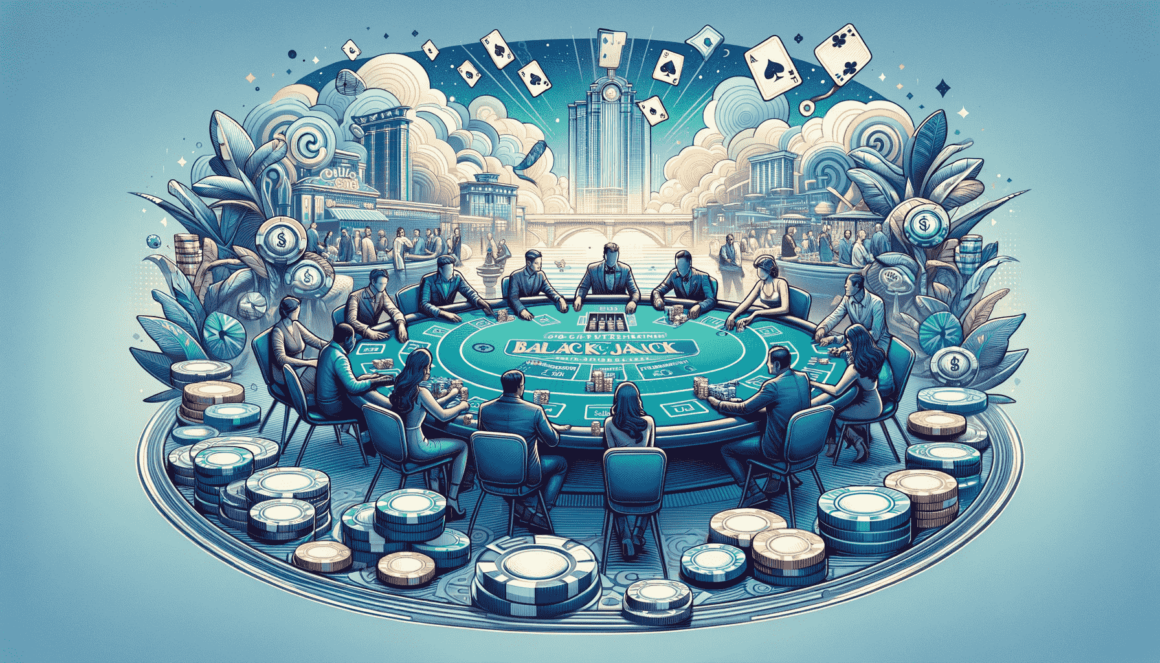
Blackjack is a fascinating casino game that offers a perfect blend of simplicity and complexity. Its basic rules are easy to grasp, making it accessible even to novice players.
However, beneath this apparent simplicity lies a deeper layer of complexity. Successful players quickly realize that Blackjack is more than just a game of chance.
Players must employ strategic decision-making based on their hand value and the dealer’s upcard to maximize the odds.
Existing Factors of the Game: Player, Dealer, and Strategy
Understanding your role, the Dealer’s actions, and the impact of intelligent strategies will be the keys to unlocking the excitement and potential rewards of Blackjack.
The Player
In Blackjack, the player is central to the action. Each player competes against the Dealer, aiming to achieve a higher hand value without exceeding 21.
Their choices, such as hitting, standing, doubling down, or splitting, significantly impact the outcome of each hand.
Deciding when to take risks and when to play conservatively is essential in maximizing the chances of winning.
The Dealer
The role of the Dealer is to manage the game and follow the rules the casino dictates for their actions. These rules often include hitting on a hand value of 16 or less and standing on a hand value of 17 or more.
The Dealer’s actions are predictable, adding an element of certainty to the game, which players can use to their advantage.
The Strategy
The game of Blackjack is as much about strategy as it is about luck. Players must analyze their hand and the Dealer’s upcard to make informed decisions.
Memorizing and applying basic Blackjack strategy charts can significantly improve a player’s odds of winning. Moreover, more advanced players may employ card-counting techniques to identify favorable situations and adjust their bets accordingly.
Blackjack 101: Terminologies
This glossary includes specialized Blackjack terms, helping beginners understand the language experienced players use for betting and discussing the game’s features:
- 86’d – In Blackjack, being “86’d” refers to being banned or excluded from a casino due to suspected card counting or undesirable table behavior.
- Ace – In Blackjack, the value of an Ace can be 1 or 11, depending on strategy and hand value. It’s a dynamic edge for players.
- Action – The total amount of money wagered during a Blackjack session.
- Advantage – The mathematical edge a player or the casino holds over another in Blackjack is based on factors like strategy, card counting, and rule variations.
- Anchorman – The player seated last at a Blackjack table who plays their hand before the dealer is often considered a crucial position.
- Back Counting – Observing a Blackjack table without placing bets is commonly used to find favorable situations before joining the game.
- Back Off – It is when a casino asks players to leave the Blackjack table, often due to suspected advantage play.
- Balanced Count – It is a card counting system where the sum of the card values in an entire deck is zero, like the Hi-Lo system.
- Bankroll – A player allocates a designated sum for gambling during a Blackjack session.
- Bet Spread – The range of bet sizes a player uses during a Blackjack session is often adjusted based on the count.
- Burn Card – The top card from the shoe is discarded facedown before dealing starts.
- Bust Card – The next card will cause the player’s hand to exceed 21, leading to a loss.
- Camouflage – Techniques card counters use to conceal their advantage play from casino personnel.
- Card Counting – It is a strategic method of tracking the ratio of high to low-value cards remaining in the deck to adjust betting and playing decisions.
- Cold Deck – It is a deck or shoe of cards with unfavorable outcomes for players, leading to losses.
- Color Up – Exchanging more minor denomination chips for higher-value chips.
- Cut Card – Place a colored plastic card in the deck to indicate when to reshuffle the cards.
- Deck Penetration – The percentage of cards dealt from the shoe before reshuffling.
- Deviations – Adjusting basic strategy plays based on the card count.
- Discards – Cards that have been played and placed in the discard tray.
- Double Down – It is the Doubling of the original bet after receiving the first two cards, with the player receiving one additional card.
- Early Surrender – It is to surrender half the bet before the dealer checks for a natural Blackjack.
- Even Money – Accepts a payout of 1:1 when the dealer’s upcard is an Ace, and the player has a natural Blackjack.
- Expected Value (EV) – The average outcome of a specific play regarding profit or loss.
- First Base – The seat to the dealer’s immediate left is where the first dealt player’s hand is.
- Flat Bet – Betting the same amount on every hand.
- Half-Shoe – The point in the shoe when half of the dealt cards have been.
- Hard Hand – It refers to a hand in which there’s no Ace or where the Ace is valued as 1 to prevent exceeding 21 points, also known as “busting.”
- Hard Total – The total hand value without considering Ace’s flexibility.
- Heads Up – Playing Blackjack with the dealer one-on-one, without other players.
- Hit – Requesting an additional card to improve the hand’s total.
- Hole-Carding – Gain knowledge of the dealer’s hole card to inform strategic decisions.
- House Edge – The casino’s percentage statistical advantage over players.
- Index – It is the value at which a specific deviation from the basic strategy is suggested based on the card count.
- Insurance – It is a side bet offering protection against the dealer’s natural Blackjack when their upcard is an Ace.
- Late Surrender – Players can surrender their hand once the dealer confirms the absence of a natural Blackjack.
- Multi-Deck – It is a Blackjack variant played with multiple decks of cards.
- Natural (Blackjack Hand) – It’s a winning hand formed by an Ace and a 10-value card, securing an immediate victory.
- Pit – It is where Blackjack tables are located and managed by casino personnel.
- Ploppy – A derogatory term for an inexperienced or unskilled Blackjack player.
- Preferential Shuffle – Prematurely shuffling the cards in response to suspected advantage play.
- Risk Of Ruin (ROR) – The probability of losing one’s entire bankroll.
- Round – It is a complete sequence of hands, starting from the shuffle until the next shuffle.
- Running Count – It is to count the sum of the current card values used in card counting.
- Shoe – A device holding multiple decks of cards used in Blackjack.
- Shoe Game – A Blackjack game played with multiple decks dealt from a shoe.
- Shuffle-Tracking – It is the technique of predicting card clusters by observing shuffling and tracking them during play.
- Soft Hand – It is a hand featuring an Ace valued at 11, providing more strategic choices in gameplay.
- Soft Total – The total hand value, including an Ace, counted as 11.
- Split – It is dividing a pair of cards into two hands and placing an additional bet.
- Spooking – It is a form of cheating where a player’s accomplice watches the dealer’s hole card and signals it to the player.
- Stand – Choosing to receive fewer cards and keeping the current hand value.
- Surrender – Giving up half the bet and forfeiting the hand.
- Toke – It is a tip or gratuity given to the dealer.
Blackjack Simplified: The Objectives of the Game

Each player dealt two cards and must make strategic decisions to achieve a hand value higher than the dealers’ without going bust (exceeding 21).
The comparison of the player’s hand to the dealer’s, and the one with the higher value, not exceeding 21, wins the round.
If a player’s hand equals 21 on the two card deals (a 10-value card and an Ace), they have a “Blackjack” and receive a higher payout.
Need help understanding the game? Here’s a scenario to easily understand:
Scenario 1 – Player’s Hand:
- The player receives a card of 7 and a 9, totaling 16. The dealer’s upcard is a 5.
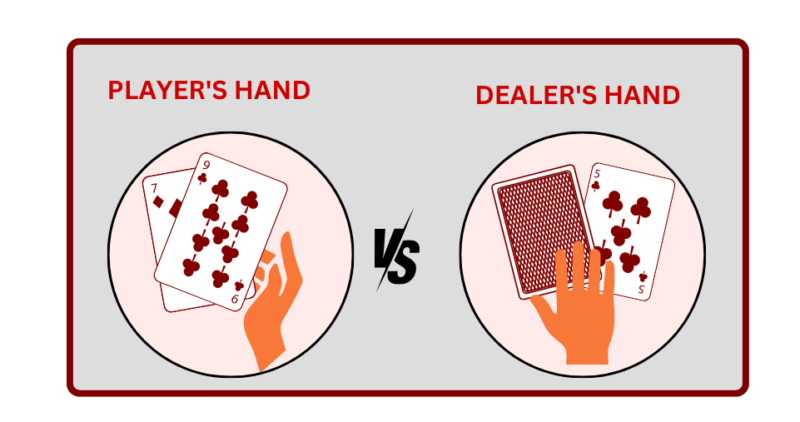
- Following the basic strategy, the player decides to “hit” to get a card that will not cause a bust. The player draws a 3, bringing their total to 19. The player stands, confident that their hand beats the dealer’s potential hand.
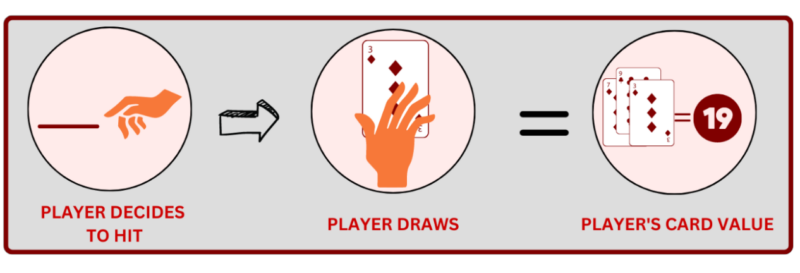
Scenario 2 – Blackjack
- The player dealt an Ace and a King, resulting in a natural Blackjack (hand value of 21). The dealer’s upcard is a 10.
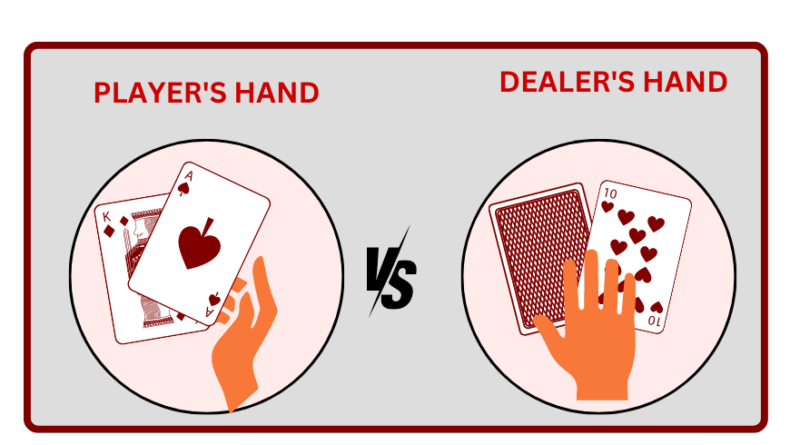
- The player is thrilled to have a Blackjack, knowing they automatically win the round unless the dealer also has one.
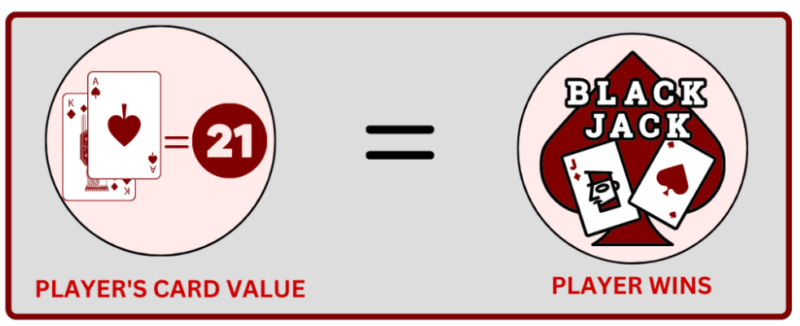
Scenario 3 – Doubling Down
- The player receives a card of 9 and a 2, totaling 11. The dealer’s upcard is a 6.
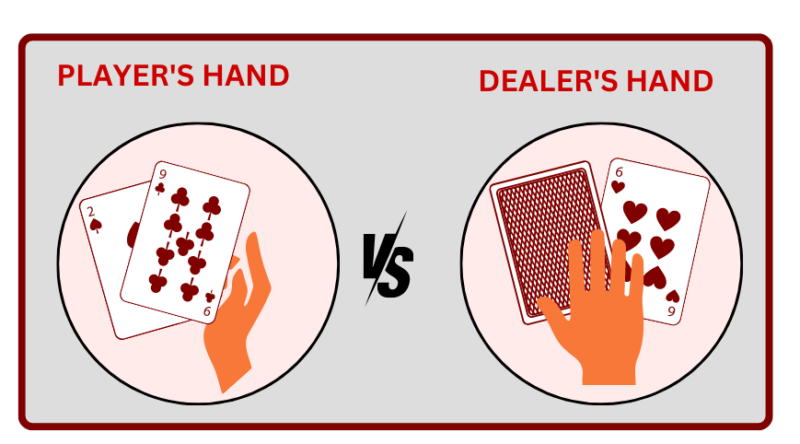
- Knowing that an Ace or a 10-value card would give them a strong hand, the player decides to “double down” and double their initial bet.
- The player draws an 8, resulting in a hand value of 19, likely to beat the dealer’s potential hand.

By understanding the game’s objectives and employing strategic decision-making, players can enhance their chances of success and experience the thrill of triumph at the Blackjack table.
At its core, Blackjack is gambling. Learning about the game’s variants, types of bets and options, and their odds and probabilities will dictate your wins and losses.
Blackjack’s Simple Math: Card Values
Understanding card values are the backbone of the Blackjack strategy.
Players use this knowledge to make informed decisions during each hand, aiming to build the most substantial hand possible without exceeding 21.
By mastering the card values and employing effective strategies, players can enhance their Blackjack experience and increase their chances of success.
Card Values in Blackjack
Number Cards (2-10):
The number cards in Blackjack, from 2 to 10, hold their face value. For instance, a card of 2 is worth 2 points, a card of 5 is worth 5 points, and so on.

Face Cards (Jacks, Queens, Kings):
Face cards include Jacks, Queens, and Kings, all valued at 10 points each. So, whether it’s a Jack, Queen, or King, they all contribute 10 points to the total hand value.

Ace:
In Blackjack, the Ace stands apart, embodying a distinct role. It can represent a value of either 1 or 11 points, aligning with the player’s optimal advantage.
Combining an Ace and a 10-value card (10, Jack, Queen, or King) results in a Blackjack, the highest-scoring hand.

Learning the Basics–Blackjack Mechanics and Rules
Blackjack Step-by-Step Guide:
Step 1: Join a Table
Take a seat at the blackjack table along with other players. The dealer at the front of the table deals two cards to each player, face up, and two for themselves – face up and face down.
In Blackjack, the card values are the foundation of the game’s simple yet intriguing math.
Each card holds a specific point value, and understanding these values is essential for making strategic decisions during gameplay.
Blackjack is mainly played at a table of 2-7 players and uses one to eight 52-card decks.
Step 2: Decide whether to Hit or Stand
Calculate the total value of your cards and the dealer’s face-up card. Aim to get as close to 21 as possible without going over.
You can rely on your intuition or use a blackjack strategy cheat sheet for guidance.
Hit: Ask for another card if you’re confident it won’t make you over 21 or willing to take the risk.
Stand: If your hand is already relatively high (over 17), you can stop receiving cards and let the dealer move on to the next player.
Step 3: Your Hand Value
Your hand will have a new total value based on your decision (hit or stand). You remain in the game if your hand value is 21 or lower.
Step 4: Dealer Reveals Their Cards
The dealer reveals their face-down card after all players decide.
Step 5: See Who is Closer to 21
You win if your hand value is closer to 21 than the dealer’s! But if the dealer’s hand is closer to 21 or they have a total of exactly 21, the dealer wins.
Step 6: Collect Your Winnings
If you win, the dealer will pay your winnings based on your bet. The amount you receive depends on the type of bet you placed.
Table Layout
Are you looking to make the best decisions while playing blackjack? Blackjack strategy charts serve as valuable guides for players.
Crafting these charts with probabilities and statistics helps players make well-informed decisions in different scenarios.
In this section, you will be taught about the important strategy table for the commonly used 6- to 8-deck Las Vegas Strip rules.
Keys:
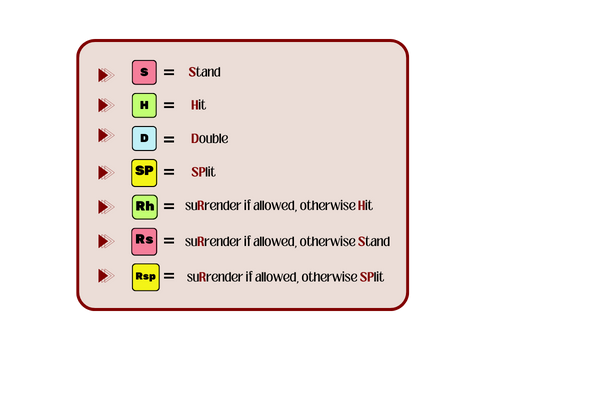
Hard Totals
The hard hand does not contain an Ace or an Ace that must be counted as 1 to avoid busting.
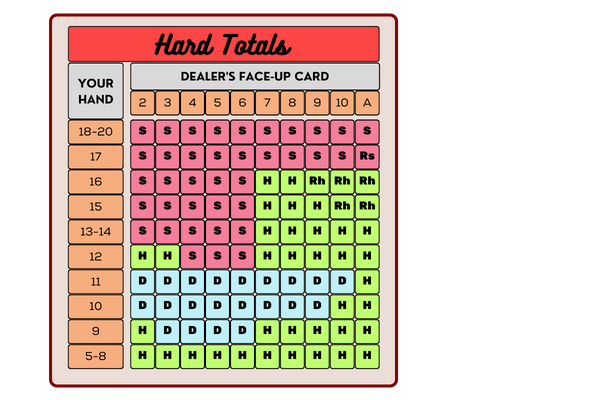
- Stand on 17 and up.
- Stand on 16 against dealer 2-6, otherwise hit.
- Stand on 15 against dealer 2-6, otherwise hit.
- Stand on 14 against dealer 2-6, otherwise hit.
- Stand on 13 against dealer 2-6, otherwise hit.
- Stand on 12 against dealer 4-6, otherwise hit.
- Always double down on 11.
- Double down on a card of 10 against dealer 2-9, otherwise, hit.
- Double down on a card of 9 against dealer 3-6, otherwise hit.
- Always hit on a card of 8 and below.
Soft Hands
A hand with a total value not exceeding 21 and an Ace valued at 11 is called a soft hand.
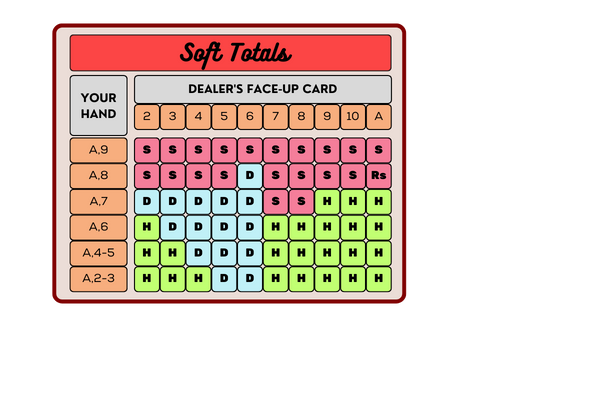
- *Stand on a Soft hand of 20 (A,9)
- *Double down on a Soft hand of 19 (A,8) against dealer 6; otherwise, stand.
- *Double down on a Soft hand of 18 (A,7) against dealer 2-6 and hit against 9-A; otherwise, stand.
- *Double on a Soft hand of 17 (A,6) against dealer 3-6; otherwise, hit.
- *Double on a Soft hand of 16 (A,5) against dealer 4-6; otherwise, hit.
- *Double on a Soft hand of 15 (A,4) against dealer 4-6; otherwise, hit.
- *Double on a Soft hand of 14 (A,3) against dealer 5-6; otherwise, hit.
Pair Hands
Pair hands are when a player receives two cards of the same rank, and a pair hand emerges, allowing them to split the pair into two hands, increasing their potential for winning.
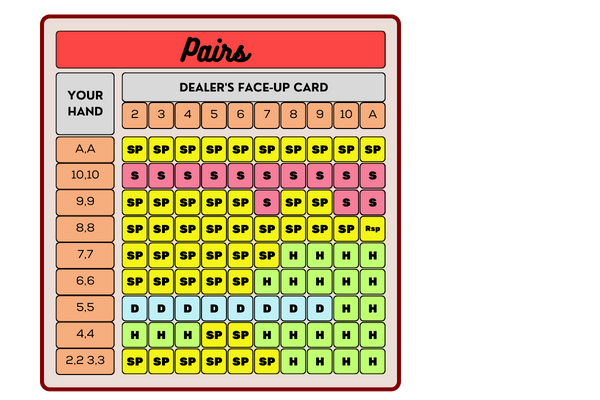
- Always split aces.
- Never split tens.
- Split a pair of 9’s against dealers’ 2-9, except for 7; otherwise, stand.
- Always split 8’s.
- Split a pair of 7’s against dealers’ 2-7; otherwise, hit.
- Split a pair of 6’s against dealers’ 2-6; otherwise, hit.
- Double down a pair of 5’s against dealer 2-9; otherwise, hit.
- Split a pair of 4’s against dealers’ 5 and 6; otherwise, hit.
- Split a pair of 3’s against dealer 2-7; otherwise, hit.
- Split a pair of 2’s against dealer 2-7; otherwise, hit.
Hand Signals
These are essential in blackjack to communicate your decisions without verbalizing them.
Standard hand signals include:
Hit

- When holding a low hand, players can ask the dealer for an additional card, such as 10 points or less.
- However, if this card causes their total points to exceed 21, it results in a “bust” or loss.
- The move: Gently tap the table with your finger next to your cards.
Stand

- When the player expresses satisfaction with their points total, such as a hand of 17 or more, and actively chooses to “stand,” remaining with the hand.
- The move: Wave your hand horizontally over your cards.
Double-Down

- Players can double their initial bet after receiving the first two cards and receive one more card to improve their hand.
- The move: Place an additional bet next to your original bet and show one finger (index finger) to indicate you want only one more card.
Split

- If a player is dealt a low hand of 10 points or less, they may ask the dealer for an additional card.
- If the total points of this card exceed 21, it is considered a “bust” and results in a loss.
- The move: Gently tap your finger on the table behind your cards.
Surrender

- Not all casinos offer this option, but if available, you can give up half your bet after seeing your first two cards and the dealer up-card.
- The Move: Draw an imaginary line behind your cards with your index finger.
Rules
Understanding the rules of this classic card game is crucial for an enjoyable and strategic gaming experience. It sets the stage for exciting moments at every turn of the cards.
The guiding rules for your advantage are listed below:
1. Player-Friendly Rules in Blackjack:
Double Down
You can double your bet on any two-card hand, except when you already have a blackjack. It will let you increase your bet when you feel confident about winning.
Double After Split
After splitting your cards into two hands; you can double down on each new hand. It gives you more opportunities to win, especially against a dealer’s weak card like 6.
Early Surrender
Players who lack confidence in their hand and fear losing may choose to forfeit half of their bet before the dealer checks for a possible blackjack.
Learn how to use “surrender” wisely to minimize losses in unfavorable situations. Adding a tactical element to the game gives players more choices than simply hitting or standing.
Late Surrender
You can also surrender after the dealer checks for blackjack, but this rule is uncommon.
Resplitting Aces
If you have a pair of aces and split them, so casinos let you split them again. It prevents you from getting stuck with a lousy total of 12.
Drawing Multiple Cards after Splitting Aces
You can still get a soft hand when you split aces and draw more cards (where an ace counts as 11). This can give you a better chance of winning if the dealer has a strong card.
Charlie Rule
If you can draw five or more cards without going over 21, it’s an automatic win uncommonly seen in casinos.
2. Bad Rules in Blackjack
6:5 Payout on Blackjacks
Avoid games where blackjack pays less than 3:2 (like 6:5 or even 1:1). This has become common in some single-deck games in Las Vegas since 2003.
It’s the worst rule for players, as it increases the house edge significantly, making you lose money much faster.
Player Losing Ties
When a tie occurs, it’s terrible if you lose. It happens almost 8% of the time. With this rule, you’ll lose money over twenty times faster. Even when the dealer’s cards face up, it hurts the player more.
3. Rules that Slightly Increase the Casino’s Advantage
Dealer Hits on Soft Seventeen
When the dealer has an ace and a six, they will take another card. It will make it more likely for the casino to get a higher total.
Splitting Limited to Once
In some games, you can only split your hand once, turning it into two hands. But be careful, as you might end up with the same weak hand you started with.
When this rule is applied, splitting eights less often is better, especially when the dealer has tens or aces.
Double Down Restrictions
In certain games, you can only double down on specific total values, like 9-11 or 10,11. Plus, you can’t hit on soft totals where you might have an advantage.
Aces may not be Resplit
If you split your Aces and get another Ace, some games won’t allow you to separate them again. It can limit your chances of winning with two strong hands.
No-Peek (European) Blackjack
In this game, the player loses both splits and doubles if the dealer has a blackjack, rather than losing the original bet.
So, when playing this version, be cautious when splitting or doubling against a dealer’s ten or ace.
“Vingt-Un”: The History Behind One of Gambling’s Most Loved Games
Blackjack, a beloved casino game steeped in a rich global history, possesses an alluring charm that transcends cultures and eras, making it a prime choice for online casino enthusiasts.
The game’s roots can be traced to the 16th-century French game “vingt-un,” which served as a precursor, setting the groundwork for the modern version we enjoy today.
This early version captured the attention of notable individuals, including King Louis XV’s mistress and even Napoleon Bonaparte.

In the 1800s, French colonists brought “Vingt-un” to America, where it underwent rule adjustments and garnered the name “21.”
The game took hold in gambling establishments in New Orleans, where specific rules emerged, such as limitations on doubling down exclusively for the dealer.
As it progressed and went through several improvements, Blackjack became a popular game in the biggest casinos worldwide, gradually becoming the well-known casino classic it is today.
Side Note
Check out this article to discover what the biggest and most prestigious Casinos in the world are.
Find out which venues offer the best rounds of Blackjack, among other games.
This section explores the diverse array of blackjack variations that have surfaced:
The Various Types of Blackjack
This card game was dubbed “Blackjack” in 1899, originating from American casinos when they started paying ten times the bet for a hand containing a Jack of Clubs or Spades and an Ace of Spades.
Over time, Blackjack has evolved and taken on various forms, leading to different blackjack variants.
Each variant has its own unique set of rules and mechanics. Get ready to explore some of the most popular blackjack variants and their origins:
Spanish 21
A thrilling variation of blackjack originating in the US. One of its distinctive features involves removing all the tens from the deck, which reduces the total number of cards to 48.
Despite this change, players aim to reach 21 or the closest hand value without exceeding it. Spanish 21 offers exciting bonus payouts for specific hands, such as:
- A five-card 21, or
- 6-7-8, or
- 7-7-7 combination of mixed suits.
21st-Century Blackjack (Vegas Style)
Also known as Vegas Style Blackjack, this variant is popular in Las Vegas casinos.
In this version, players have the option to “bust” on certain hand totals, meaning they can exceed twenty-one and still have a chance to win if the dealer also busts.
Additionally, the game allows for bonus payouts based on specific hand combinations.
Double Exposure Blackjack
It introduces a unique twist: the game deals with both dealers’ initial cards face-up.
While the twist gives players more information about the dealer’s hand, it comes with a catch—blackjacks only pay even money instead of the standard 3:2 payout.
Double Attack Blackjack
It is an exciting variant originating from Atlantic City. Players can double their initial bet after seeing the dealer’s up card in this game.
It creates a dynamic gameplay experience, as players can adjust their bets based on the perceived strength of the dealer’s hand.
Blackjack Switch
It is a clever variant allowing players to play two hands simultaneously and swap cards.
This unique feature gives players more control and strategic opportunities, adding excitement to the game.
Super Fun 21
This variant incorporates a range of player-friendly rules, including the ability to double down on any number of cards and offer bonuses for specific hand combinations.
While these rules favor the player, the game compensates by implementing a natural blackjack payout of even money instead of the standard 3:2.
French Vingt-et-un
As aforementioned, Vingt-et-Un originated from the historical French version of blackjack.
While less commonly played today, it is essential to acknowledge its influence on the game’s development.
German Siebzehn und Vier
Siebzehn und Vier, meaning “seventeen and four” in German, is another historical predecessor of blackjack.
It dates back to the 17th century and shares similarities with the modern game, such as aiming for a hand value close to twenty-one.
How to Win the Game:
Players must aim for a hand value that beats the dealer’s hand without busting to win at Blackjack. Players have several strategic choices at their disposal:
Basic Strategy
- Following a basic strategy chart helps players make the optimal decisions based on their hand and the dealer’s upcard. It reduces the house edge and enhances the player’s chances of winning.
Hit or Stand
- Players decide whether to “hit” and request an additional card or “stand” and keep their current hand. The hand value influences the decision, the dealer’s upcard, and the likelihood of going bust.
Doubling Down
- Players can double their original bet after receiving the first two cards if they believe a single additional card will give them a strong advantage.
Splitting Pairs
- When a dealt pair of cards of the same rank, players can split them into two hands, doubling their bet and playing each hand independently.
Insurance
- Players can opt for insurance when the dealer shows an Ace as their upcard—a side bet that pays out 2:1 if the dealer has a blackjack.
Basic Blackjack Rules Made Easy
Understanding the payouts and right moves based on your hand will help you master the game. Take a look at these simple rules:
Regular Wins
- You win when your cards are closer to 21 than the dealer’s, and your payout is 1:1.
Blackjack Wins
- If your cards equal 21, you get a “Blackjack” and receive a higher payout of 3:2.
16 and Below
- If the dealer’s hand value is 16 or lower, they must take another card.
Hit or Stand
- You can “hit” for an additional card or “stand” to maintain your current total, allowing the dealer to proceed to the next player.
Advanced Betting Options
These strategic options can help your gameplay and guide your choices.
Insurance
- When the dealer’s Ace is a face-up card, you can take insurance as a safeguard against the possibility of their Blackjack.
Surrendering
- In some casinos, you can surrender half your bet if you don’t like your hand.
Soft 17
- When the dealer has a soft 17, some casinos require them to hit, while others make them stand.
Taking Even Money
- If you have a Blackjack, but the dealer shows an Ace, you can opt for even money (1:1) instead of the standard payout (3:2).
Tips to Improve Your Chances of Winning:
Never Split Two-Face Cards
- Avoid splitting face cards like kings and queens, as it’s not statistically favorable.
Always Split Aces & 8s
- Splitting Aces and 8s gives you better odds of forming winning hands.
Side Note
Manage your budget and follow an essential strategy guide.
Blackjack offers excellent value when played smartly, so stay focused, keep your nerve, and you’ll soon be playing like a pro.
Enjoy the excitement and test your strategies, but always bet responsibly to make the most of your Blackjack experience!
Tips for Pro-Players
Before approaching virtual blackjack tables, consider these essential tips (you can find more detailed advice in our guide):
Bet within Your Means
- Never chase losses, avoid betting more than you can afford, and set a budget before playing.
Learn the Basics
- Memorize the fundamental blackjack strategy to make informed decisions during the game. Keep the strategy guide handy for quick reference.
Bet Responsibly
- Avoid reckless play by not betting more than half of your stack on a single bet. Responsible betting ensures a more enjoyable experience.
Stay Composed
- Don’t get discouraged by bad luck with cards. Holding your nerve and sticking to your strategy increases your chances of long-term success.
Blackjack Odds and Probability
In Blackjack, the house always has an advantage over players, even if they master the basic strategy.
It is because players have to act first; if they bust, they lose regardless of whether the dealer also breaks. However, players have the tools to reduce the house edge significantly.
Did You Know?
Players prefer Blackjack over Roulette because it offers better winning odds than Roulette.
In Blackjack, players employ strategies and choices to impact the outcome. In contrast, Roulette leans heavily on chance and luck.
House Odds and Bust Probability
There’s a clever strategy you can use to assess the dealer’s chances of success before you even take a look at your cards.
The key is to focus on their potential to go bust, which would secure an instant win for you. It may seem like a game of luck, but you can estimate the average bust rate based on the dealer’s first card, the up card.
To help you remember this valuable tactic, here’s a handy cheat sheet:
- Up card: The first card is drawn face up.
- Bust-out: A hand value exceeding the value of 21.
| Dealer Up Card | Bust Rates |
| 2 | 35.30% |
| 3 | 37.56% |
| 4 | 40.28% |
| 5 | 42.89% |
| 6 | 42.08% |
| 7 | 25.99% |
| 8 | 23.86% |
| 9 | 23.34% |
| 10 | 21.43% |
| A | 11.65% |
Player Odds and Bust Probability
Just like you analyzed the dealer’s hand, you can apply the same strategy to evaluate your hand and determine your chances of success.
The main distinction is that you know your two-card hand from the start. Unlike the dealer, your goal is to minimize the risk of going bust when you decide to hit.
To help you make the most of your two-card hand, here’s another helpful table for reference:
- Hit: Adds card to the value.
| Player Hand Value | Overall Odds of Going Bust from a Hit |
| 11 and under | 0% |
| 12 | 31% |
| 13 | 39% |
| 14 | 56% |
| 15 | 58% |
| 16 | 62% |
| 17 | 69% |
| 18 | 77% |
| 19 | 85% |
| 20 | 92% |
| 21 | 100% |
Odds of Winning
In the thrilling game of blackjack, the question remains: How often can you expect to emerge victorious? These are the odds for each possible outcome when the moment of truth arrives:
| Player Odds of Winning | Dealer Odds of Winning | Draw Odds (Tied Game) |
| 42.22% | 49.10% | 8.48% |
Did You Know?
No Bust Blackjack is a well-liked card game in California, where regular Blackjack is legally restricted.
“No bust” Blackjack can be considered more advantageous than regular Blackjack.
It eliminates the possibility of a player’s hand exceeding a total value of 21, which is called going “bust.”
Keys To Victory–Blackjack Strategies
Here are strategies for newcomers like you, ensuring you’re well-prepared to approach the blackjack table with confidence:
- Take it easy at the blackjack table and start small to get a feel for the game.
- Before making any moves, check the dealer’s up card — knowing if it’s good or bad can significantly influence your strategy.
- Avoid falling for the insurance bet trap unless you’re counting cards.
- Don’t be swayed by gamblers’ myths, as your decisions are independent of others at the table.
- Lastly, limit your losses while keeping your potential winnings open.
- Stay smart and enjoy the thrill of blackjack without getting burned.

Composition-Dependent Strategy
Composition-dependent strategy is an essential part of blackjack that can take your game to a new level. It’s what separates regular players from skilled ones.
If you want to play blackjack seriously and seek to improve your chances of winning, you must learn about composition-dependent techniques.
The game constantly changes in blackjack depending on how they dealt cards. A basic strategy can help you in some situations, but it’s not enough to master the game completely.
That’s where the composition-dependent strategy comes in. It considers all the cards on the table, not just your starting hand, and helps you make better decisions based on what’s happening.
| For example: You might always stand on a total of 12. But with a composition-dependent strategy, you’ll consider the specific cards you have. Standing might be better if you have a card of 9 and a 3. But if you have a card of 10 and a 2, it could be wiser to hit or even double down. |
A composition-dependent strategy can give you a natural edge, especially when playing online blackjack. It’s like having an extra tool to make better decisions and increase your chances of winning.
However, remember that composition-dependent strategy works best in certain situations, like single-deck games, which are rare in traditional casinos.
But online casinos often offer single-deck games, making it a valuable learning strategy for online players.
Side Note
Learning composition-dependent strategy might take some time and practice, but it’s worth it if you want to become a more skilled blackjack player.
It can make your gaming experience more enjoyable and rewarding and even help you win more often!
9 Truths About Blackjack Advantage Play
Blackjack is an exciting game that beginners can quickly learn, but mastering it requires skill and strategy.
Here are some essential facts:
1. Blackjack games are not the same: Different casinos have different rules and options that may affect your advantage. One of the worst rule changes is when a casino only pays 6 to 5 on a blackjack
2. Mastering the Correct Blackjack Basic Strategy: Learning basic strategy is your best defense in lowering the casino’s advantage.
3. Progressive betting systems cannot beat the game: It is crucial to know that money management strategies do not offer a means to win the game.
4. Watch out for Card Counting: Counting cards is not illegal, but casinos can remove players they suspect of being skilled card counters.
Side Note
Card Counting is generally banned in casinos worldwide, though it is not considered illegal. This is because the act reduces the casino’s mathematical advantage over players.
5. Focusing on Effective Techniques: You don’t need to fully understand the math behind advantage techniques to beat the game. Practicing and implementing the necessary strategies is what matters most.
6. Building Blackjack Teams: Teams have advantages like larger bankrolls, reduced particular risk, and the ability to scout tables and disguise big bets. However, trust among team members can be a challenge.
7. Mastering Key Effective Strategies: While some professionals memorize numerous variations, players can achieve a substantial portion of the benefits from card counting by learning only 18 plays, with an additional four if surrender is allowed.
8. Advantage of Techniques in Blackjack: These techniques, including hole carding, are not cheating but taking advantage of specific opportunities in the game.
9. Overbetting the bankroll: It’s crucial to manage your bankroll wisely and avoid excessive risks to have a fighting chance at winning.
Final Thoughts
When playing blackjack, you must understand the basic rules and objectives and know the basic strategy to minimize the risk of losing everything and improve your chances of winning.
It’s important to manage your bankroll wisely by setting limits and never betting more than you’re comfortable losing.
One should remember that blackjack is a game of skill combined with chance, so keeping a clear head and following these principles can help enhance your odds of success.
FAQ
Does Blackjack Offer the Best Odds for Casino Gamblers?
Blackjack provides the best odds for casino gamblers, ranging from around 0.19% to 1%.
Why Can't I Use My Cell Phone?
Casinos ban cell phone use to prevent cheating, like sharing hole card information or tracking card counts, which is strictly forbidden.
What Is a "Natural" in Blackjack?
A “natural” or “blackjack” refers to a two-card hand with an ace and any 10-valued card, regardless of the card’s color or whether it’s a jack.
What Is a 6:5 vs. 3:2 Blackjack Game?
The terms “3 to 2” and “6 to 5” indicate the payouts for a natural blackjack, where one pays $6 for every $5 wagered, and the other pays $3 for every $2 wagered.
Can You Play Blackjack Online?
Many online casinos offer virtual blackjack games where you can play against computers or live dealers.
How Can I Improve at Blackjack?
Learn and practice basic strategy, manage your bankroll, and play responsibly to improve your blackjack skills.
 BC.Game
BC.Game  7Bit
7Bit  Ducky Luck
Ducky Luck  Red Dog
Red Dog